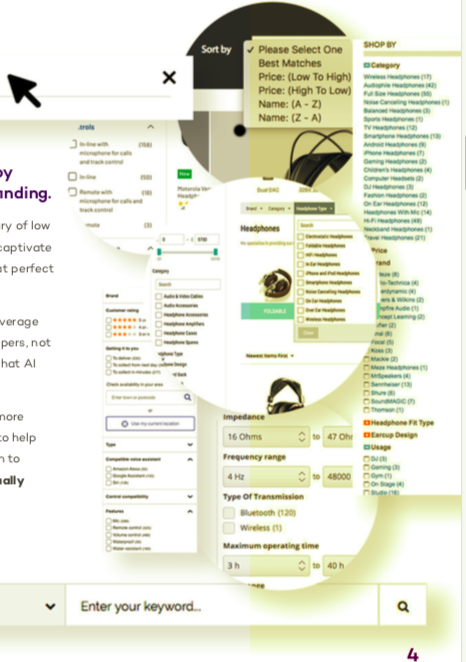Think about the last time you searched for a product online. If you’re like 93% of digital shoppers, the experience started out in a search box with a few keywords that felt relevant to your desired purchase. Seconds later, a surge of results flooded the browser with sponsored ads from major retailers and brands and followed by organic results. The long journey to purchase begins as you try to navigate thousands of results across channels.
Simply put: search and discovery experiences are not enjoyable. Consumers like finding products, not searching for them. The exhausting process of refining keywords, checking off filters, and comparing product descriptions in order to make a purchase has taken the joy of shopping and made it a headache. While shopping methods have evolved over the last two decades, the search experience has been pieced together from outdated practices.
The way we search hasn’t changed in nearly a century
The digital age revolutionized where we shop, but the ways we search and discover products online date back to the 1930s with a few notable advances in search experiences added over the course of the last 60 years. The three major components of our “modern” search and discovery experience are faceted or filtered search, keywords, and page rank. Each with its own impact on how consumers navigate digital search experiences.
Faceted or filtered search
The use of filters based on predetermined g roupings to organize data and identify relevant information originates from the Colon Classification system developed by an Indian academic in 1933. The intent was to help scientists and librarians find the right information without spending hours (or days) looking for a specific study or book. Faceted search dominates ecommerce sites–the sidebar where consumers check boxes to attempt to narrow down the search is the modern-day Colon Classification system.
roupings to organize data and identify relevant information originates from the Colon Classification system developed by an Indian academic in 1933. The intent was to help scientists and librarians find the right information without spending hours (or days) looking for a specific study or book. Faceted search dominates ecommerce sites–the sidebar where consumers check boxes to attempt to narrow down the search is the modern-day Colon Classification system.
Keywords
Depending on the source, some say the use of keywords dates back to the development of SEO in the early 1990s, but the concept of weighing specific terms based on relevance and term dependency was developed in the 1960s by scientists at Cornell University. Today, the search box across channels requires consumers to know exactly what they are searching for because the use of keywords is the preferred way for businesses to classify their products.
PageRank
The only component of today’s search experience that is actually relatively new: Google incorporated PageRank into search results in 2000. PageRank factors in the trustworthiness and the number of web links directed to a result to determine what shows up in any given search. This remains a factor when using the search box–it’s why SEO, building backlinks, and domain authority is a billion-dollar business.
None of these components consider how humans intuitively shop for any product-we don’t go into a store and say “show me the most popular item, regardless of it fits my needs.” Each time a consumer decides to purchase something online they are gambling with the search box.
The experience is outdated, and consumers are facing a myriad of challenges whenever they shop.
Three Challenges Modern Consumers Face
Now that we’ve established the origins of today’s search and discovery experience, it’s time to understand how it impacts consumers as they shop on digital channels. Remember how we asked you to think about the last time you shopped online? How did you feel when your browser flooded with options? Chances are you experienced one of three (or maybe all three) of the challenges and frustrations your consumer feels every time they search:
Choice overload: A simple search for “eye cream for wrinkles” generates over 10,000 results on Amazon. Try narrowing down that with faceted search by selecting options only for women and combination skin: 3,000 results. Over 54% of consumers are overwhelmed by the amount of choice available.
FOBO: The consumer cousin of FOMO, the Fear of Better Options, is the feeling that there is something better available; they just haven’t found it, yet. It paralyzes our ability to make a decision.
Confusion about products: Businesses stuff product pages with technical jargon and keywords thinking a consumer understands. Consumers are not product experts, and should not be expected to parse through technical specifications and industry jargon to determine if a product is right for them.
If you’re exhausted thinking about how daunting searching online for products or services is, then you should know it is possible to solve all these problems. Delivering a superior search experience that consumers will enjoy requires leveraging product discovery.
Conversational search: the answer to outdated search experiences
The old way of shopping, when you went into a store and a salesperson would ask a few questions to narrow down options to the most relevant to your needs and requirements, is the model of a consumer-centric experience. With all their knowledge and experience, that salesperson could anticipate and understand what you wanted; it was authentic and personal. Content Discovery digitizes the human experience and intuitiveness lacking in the search experience we’ve outlined in this article.
Content Discovery is the most effective way to convert customers by leveraging AI to optimize every step of their journey. Rather than using keywords or faceted search, the consumer is asked a series of needs-based questions to narrow down the choice to 5-10 options, not thousands. The AI aspect of product discovery understands and predicts what the customer needs to increase conversion and customer satisfaction. In turn, brands and retailers ascertain valuable insights into their consumers, like product performance, channel efficiency, and buyer profiles.
Consumers deserve a better search experience, and AI-powered content discovery is the only way to deliver it.

